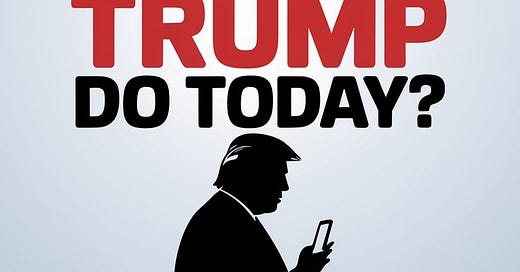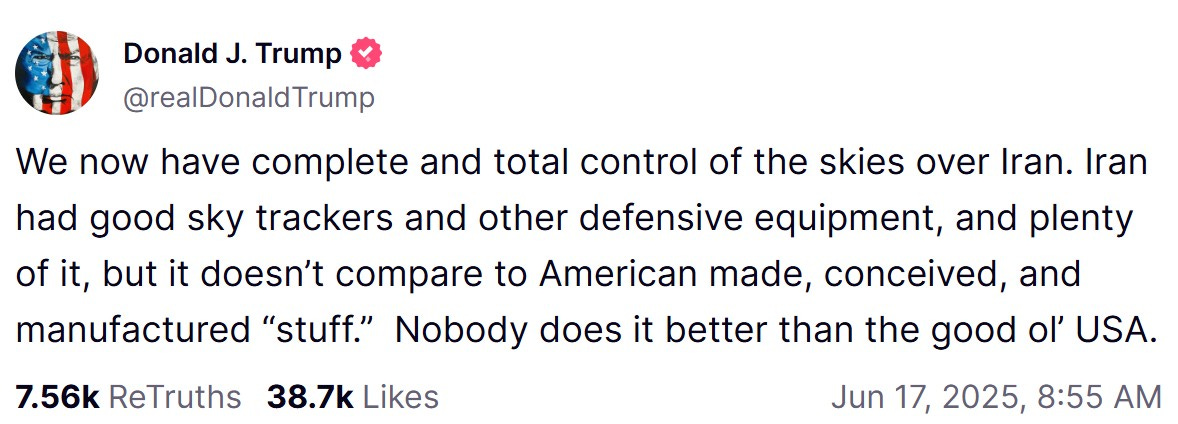Donald Trump issued two reckless and incendiary Truth Social posts that display a dangerously cavalier tone that trivializes military escalation and international diplomacy. The first message, boasting that the U.S. now has "complete and total control" of Iranian airspace, is both provocative and lacking in strategic clarity. Trump dismisses Iranian air defenses with casual bravado, referring to American weaponry as “stuff” and leaning on jingoistic slogans like “Nobody does it better than the good ol’ USA.” Such language is not only juvenile for a sitting president but risks inflaming tensions by framing complex military superiority as a chest-thumping contest, rather than a responsibility with global implications.
The second post is even more reckless, as it directly references the whereabouts of Iran’s Supreme Leader and implies the U.S. has the capability and willingness to assassinate him — but is choosing not to “at least not for now.” This kind of messaging is deeply irresponsible. It flirts with violating international norms and treaties against targeted assassinations, while also undermining diplomatic leverage by revealing intent in an unserious, almost sarcastic tone. The offhand threat, combined with the flippant “Thank you for your attention to this matter!” sign-off, reads less like a statesman addressing a crisis and more like a reality TV host delivering a warning to a contestant. The use of “kill!” in parentheses is particularly unhinged for official presidential communication, underlining the unseriousness and volatility that define Trump’s rhetoric in moments of high geopolitical tension. These posts escalate conflict while offering no coherent policy, strategic framework, or diplomatic objective — only performative dominance.
Donald Trump’s remarks aboard Air Force One en route from the G7 reveal a wide-ranging and erratic exchange, marked by contradictions, vagueness, hyperbole, and an overarching lack of coherence and diplomatic clarity. The president dismisses the notion of a ceasefire with Iran, claiming instead that the U.S. is seeking “better than a ceasefire,” yet fails to define what that means in concrete diplomatic or military terms. His comments veer from declaring that Iran cannot have a nuclear weapon — “very simple,” he says — to offering vague threats and speculations about the destruction of Iran’s nuclear program without acknowledging the practical and geopolitical consequences of military escalation.
Trump’s guidance to “evacuate Tehran” is presented as a vague gesture of concern for safety, yet it lacks substantiation and could easily be interpreted as a threat of impending military action. He repeatedly downplays the need for consultation with Congress or allies, brushing off questions about notification of the “Gang of Eight” or what his administration hopes to achieve through direct diplomacy with Iran. Meanwhile, he oscillates between saying negotiations may occur and insisting he is “not in a mood to negotiate.”
His responses to international trade are similarly muddled. He boasts about sending countries letters declaring what they “have to pay” to trade with the U.S., a flippant characterization of trade diplomacy that undermines the complex nature of bilateral and multilateral negotiations. His commentary on the UK, Japan, Canada, and the EU shows an impulsive and transactional approach that disregards established norms and often conflates tariffs with national tribute. The remark about Canada potentially joining the Iron Dome as part of a separate deal is offhand and confusing, leaving the impression that policy is being improvised on the fly.
Domestically, Trump’s statements about ICE enforcement take on a harsher tone, particularly when referring to inner cities, which he implies are harboring the “worst” immigrants. His claim that the Biden administration let in “11,888 murderers” lacks evidence and appears designed for shock value rather than policy explanation. He blames Democrats for the slow confirmation of Defense Department nominees, using caricatured references to Abraham Lincoln and George Washington to belittle Senate procedures.
Throughout, his disdain for process, governance, and decorum is apparent. He admits he doesn’t “believe in telephones” because reporters might be listening, offers exaggerated revenue claims (“$88 billion in tariffs” without context), and ends by ridiculing the governor of Minnesota following a high-profile violent crime, refusing even a symbolic gesture of outreach.
This gaggle illustrates a president who governs by bluster, eschews deliberation, and reduces complex international crises and domestic responsibilities to a stream of improvisational boasts, grievances, and vague threats. There is no consistent strategic vision, only a performance of power that masks a deficit of planning, accountability, and clarity.
The Trump administration reversed its brief pause on immigration raids targeting farms, hotels, and restaurants, despite President Trump’s earlier promise to protect undocumented workers in these industries due to labor shortages. The Department of Homeland Security confirmed the policy shift after internal White House divisions emerged—Agriculture Secretary Brooke Rollins had advocated for exemptions, but Trump adviser Stephen Miller opposed them.
On June 12, Trump appeared sympathetic to the agricultural industry, acknowledging that many undocumented migrants were long-term, reliable workers. However, just days later, ICE resumed raids in these sectors following a directive from Trump to intensify deportation efforts, especially in large, Democrat-led cities like Los Angeles, Chicago, and New York. Trump urged ICE to carry out what he called the “single largest Mass Deportation Program in History.”
This shift drew criticism from Democrats, with California Governor Gavin Newsom mocking Trump for caving to Miller’s hardline influence. Despite ICE arresting over 100,000 individuals since January—doubling the daily average from the past decade—the administration’s goal remains far more aggressive, aiming for 3,000 arrests per day and targeting up to 1 million deportations annually.
A federal appeals court appeared poised to allow President Donald Trump to maintain control over California National Guard troops deployed in Los Angeles following immigration protest unrest, despite a lower court ruling that deemed the deployment illegal. U.S. District Judge Charles Breyer had previously ordered the Guard returned to Governor Gavin Newsom’s control, arguing that Trump had exceeded his authority under Title 10, which allows for the federal activation of the Guard only in cases of invasion or rebellion—standards Breyer said the protests did not meet.
During a San Francisco appeals hearing, a three-judge panel—two Trump appointees and one Biden appointee—signaled skepticism toward Newsom’s challenge, with all judges acknowledging the president’s broad statutory discretion. However, they did not fully accept the Justice Department’s argument that courts have no role in reviewing such decisions. The outcome of this case could redefine the scope of presidential power over state National Guards.
California argued Trump failed to notify the state or consider less extreme responses, and that the deployment threatened civil liberties and state sovereignty. Newsom’s lawsuit labeled the move illegal and a misuse of military force, especially with wildfire season approaching. The ruling, when issued, could set a major precedent on federal authority and civil-military boundaries within U.S. borders.
The Trump administration’s decision to expand the federalization of National Guard troops in Los Angeles under Title 10 authority reflects an aggressive and controversial use of executive power that raises serious constitutional and practical concerns. By activating an additional 2,000 troops from the 49th Military Police Brigade, the administration has bypassed California Governor Gavin Newsom’s authority, marking the first instance since 1965 that a president has deployed a state’s National Guard without gubernatorial consent. The justification—protecting federal functions amid immigration protests—appears to conflate civil unrest with conditions akin to “invasion or rebellion,” the legal threshold required for such federal intervention under Title 10. This stretching of statutory interpretation undermines the principle of federalism and invites scrutiny over the legitimacy of the president’s actions.
Moreover, the administration’s insistence that these troops will not engage in civilian law enforcement rings hollow when the very purpose of the deployment is to exert federal presence in a politically charged environment. Governor Newsom’s condemnation rightly highlights the diversion of National Guard resources from vital tasks such as wildfire mitigation and border security, framing the move as political theater rather than a genuine security necessity. The timing of the deployment—coinciding with protests over aggressive ICE raids—further suggests a retaliatory motive rather than a preventive one. The ongoing legal battle, now before the 9th Circuit Court of Appeals, underscores the gravity of the constitutional stakes, as the court considers whether to uphold a rare and sweeping expansion of presidential authority. If allowed to stand, this could set a dangerous precedent for federal military intervention in domestic affairs, overriding state autonomy in a manner that blurs the line between national security and political opportunism.
A federal judge in Massachusetts has blocked enforcement of a Trump administration executive order that required Americans to select only their gender assigned at birth on passport applications. U.S. District Judge Julia Kobick ruled that individuals can continue to choose the gender they identify with—including the nonbinary "X" option—when applying for or renewing a passport. This expands an earlier April ruling that applied to only six plaintiffs.
The executive order, issued on Trump's Inauguration Day, reversed a Biden-era policy that allowed for gender self-selection on passports. The ACLU sued on behalf of transgender and nonbinary plaintiffs, arguing the policy was discriminatory. Judge Kobick agreed, stating the order lacked justification tied to a legitimate government interest and openly rejected the identity of transgender Americans.
The Justice Department has appealed the ruling, but the ACLU vowed to continue fighting what it called a harmful and unlawful policy. The State Department declined to comment on the ongoing litigation.
The Trump administration quietly disbanded an inter-agency working group that had been formed to develop strategies for pressuring Russia into advancing peace talks with Ukraine. According to U.S. officials, the group lost momentum in May due to President Trump’s disinterest in taking a tougher stance toward Moscow. Despite campaign promises to end the Ukraine war swiftly, Trump grew frustrated with the lack of progress and began suggesting the U.S. might abandon peace efforts altogether, rendering the group's mission increasingly moot.
The group had included officials from the National Security Council (NSC), the State Department, the Pentagon, and the intelligence agencies. It was dissolved after a broad purge of the NSC, including the removal of key personnel handling the Ukraine conflict. The move has fueled concern among European allies already wary of Trump's conciliatory approach to Russia, especially ahead of a NATO summit.
Trump’s broader diplomatic efforts, including in the Middle East, have faltered, and a parallel initiative to counter Russian disinformation was also suspended in March. Although Trump has floated the idea of new sanctions and expressed anger at Putin publicly, no concrete shift in policy has occurred. The White House and key departments declined to comment. The working group's proposed ideas reportedly included economic incentives to reduce Russian influence in the post-Soviet region; however, the effort was terminated before any of these were implemented.
A federal judge ruled that the Trump administration’s termination of hundreds of NIH research grants—many targeting health disparities in marginalized groups—was illegal, labeling the directive “arbitrary and capricious” and ordering funding for some of the canceled grants to be reinstated. The decision came in response to two lawsuits, one by several states and another by public health organizations. Judge William G. Young strongly condemned the administration's actions as discriminatory, particularly against racial minorities and LGBTQ+ communities, noting that the policy aimed to suppress research into the health needs of these populations. The NIH had halted funding for projects connected to diversity, equity, and inclusion, claiming such work lacked scientific rigor. ProPublica had reported extensively on the damage done by the terminations, including abandoned research and potential long-term harm to public health. The White House and HHS defended the cuts, accusing the judge of bias and pledging to appeal the decision. Legal experts say this unprecedented move undermines scientific independence and sets a dangerous precedent, particularly as the administration has previously ignored similar court rulings.





